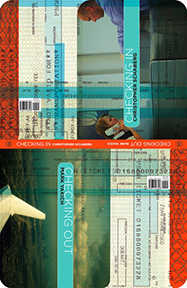I could fall the distance between the plane and the ground in a bit more than two minutes. I have no wish to do this, but it’s good to know I can still figure the relationship between terminal velocity, distance and time. Between where I am and where I could be, depending on circumstances. The man in the seat in front of me is staring out the window with the same intensity I have. I don’t know what’s holding his eyes so hard. I’m looking for whoever it was who picked up the ground below in her fist and squeezed it parallel and even back out between her fingers to make those folds in the ground below.
When a plane drops down through air pockets you discover the solidity air has. The what is in what looks like a whole lot of what isn’t. It’s as if the rises and falls, whorls and tumbles of the earth below are reflected up here right below us. I wish for a stunt plane, red smoke bellowing out behind, flying below us. The smoke would settle just below the belly of the plane on air that shapes itself to the outlines of the earth 25,000 feet below.
I hear conversations sliced through by engine noise and vibrations, the signature undulations, thrum and shake, of a turboprop. Words and phrases come to me in pieces. The man with the white beard and bad teeth three rows back says, “I don’t want to be sitting next to no kids,” and the man writing a letter in a bulkhead seat replies, “they’ll never agree to this.” I hear a baby cry two minutes after I see his face screw up distressed around some pain or fear or emptiness. Calmed only when his mother’s left hand moves the pacifier into his mouth.
The yeasty sweet smell of Jack Daniels holds tight to the man in the aisle seat. He’s poured four of the six mini-bottles he somehow got through security into small glasses of Coke he hides under the tray table. We’re only 20 minutes out of Albuquerque. I’m glad for the empty middle seat between us. Glad that he’s one of those Jack Daniels drinkers who finds quiet in the whiskey. Me, I wouldn’t have bothered with the Coke or the hiding. I ask for ice water.
Down below, there’s no water. No depressions to hold it, no patches shadowed by rain that might have fallen and escaped evaporation long enough to work its way into grains of soil. A thirsty, exhausted crater stretches forever across the earth. On my watch it takes about a minute to cross. The land below rolls on empty until there is a sudden grid of roofs. They sit on either side of a road that has no idea of where it might take somebody who finally started running away from there. I see no sign of what anyone would have stopped there for. Nothing to promise a night’s rest or safe haven, much less a place to build and keep staying. Roads hug riverbeds through canyons, roads in no danger from rising water. Those rivers have drained themselves of any hope of being what they were meant to be. I understand, then, the roofs and the houses I believe are under them. This is a land full of improbability. This is where people come when that’s what they’ve got left to go on, and they still want to keep trying.
Below, the land changes from a brown that held the promise of nothing to some slight tinge of green shook out from a loaded paintbrush overhead. The plateaus and canyons are higher and deeper, practice for the Rockies rising in the distance. Snow is scattered, melting into square fields greedy for moisture. They’ve sucked up the snow, leaving nothing for the roadsides or fallow ground. A town now, all of itself, houses, McDonald’s, grown-ups and children, a hospital, a school, a church or mosque or stupa ranged at the foot of loose black hills, waiting.
Sandra Vallie lives and writes in Albuquerque, New Mexico. She loves to fly; her favorite airplane is the C-46. She blogs at Writing It Down In The High Desert.






